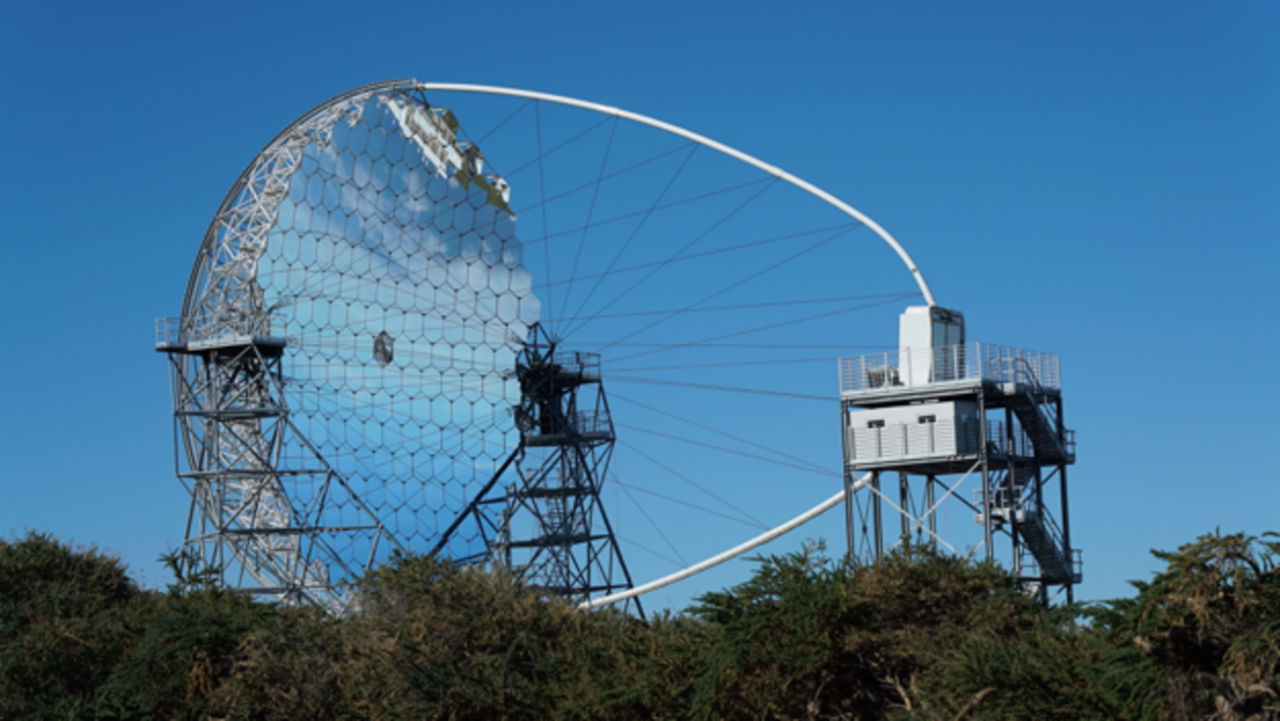Grants related:
General
The MAGIC Collaboration is integrated by 20 research institutes and university departments from Armenia, Bulgaria, Finland, Germany, Italy, Poland, Spain, Switzerland and USA. The collaboration comprises two 17m diameter telescopes, located at the Roque de los Muchachos Observatory, designed to measure the Cherenkov radiation associated with atmospheric showers from very high-energy gamma rays.
CTA is a major international collaboration for building two large Cherenkov observatories at North and South Hemispheres. Roque de los Muchachos Observatory in La Palma has been selected to host the Northern observatory. The first large size telescope was inaugurated in October 2018, and we are presently building the other three.
Members
Results
- Inauguration of the first large-size telescope of CTA (LST-1) at the Observatorio del Roque de Los Muchachos
- Detection of a neutrino generated in a blazar with MAGIC, IcCube and Fermi-LAT
- Discovery of the binary systemPSR J2032+4127/MT91 213 emitting in VHE gamma rays.
Scientific activity
Related publications
-
A search for optical and near-infrared counterparts of the compact binary merger GW190814
We report on our observing campaign of the compact binary merger GW190814, detected by the Advanced LIGO and Advanced Virgo detectors on 2019 August 14. This signal has the best localization of any observed gravitational wave (GW) source, with a 90 per cent probability area of 18.5 deg 2, and an estimated distance of ≍240 Mpc. We obtained wide
Thakur, A. L. et al.Advertised on:
122020 -
Detection of the Geminga pulsar with MAGIC hints at a power-law tail emission beyond 15 GeV
We report the detection of pulsed gamma-ray emission from the Geminga pulsar (PSR J0633+1746) between 15 GeV and 75 GeV. This is the first time a middle-aged pulsar has been detected up to these energies. Observations were carried out with the MAGIC telescopes between 2017 and 2019 using the low-energy threshold Sum-Trigger-II system. After quality
MAGIC Collaboration et al.Advertised on:
112020 -
MAGIC observations of the diffuse γ-ray emission in the vicinity of the Galactic center
Aims: In the presence of a sufficient amount of target material, γ-rays can be used as a tracer in the search for sources of Galactic cosmic rays (CRs). Here we present deep observations of the Galactic center (GC) region with the MAGIC telescopes and use them to infer the underlying CR distribution and to study the alleged PeV proton accelerator
MAGIC Collaboration et al.Advertised on:
102020 -
HORuS transmission spectroscopy of 55 Cnc e
The High Optical Resolution Spectrograph (HORuS) is a new high-resolution echelle spectrograph available on the 10.4-m Gran Telescopio Canarias (GTC). We report on the first HORuS observations of a transit of the super-Earth planet 55 Cnc e. We investigate the presence of Na I and Hα in its transmission spectrum and explore the capabilities of
Tabernero, H. M. et al.Advertised on:
82020 -
Testing two-component models on very high-energy gamma-ray-emitting BL Lac objects
Context. It has become evident that one-zone synchrotron self-Compton models are not always adequate for very high-energy (VHE) gamma-ray-emitting blazars. While two-component models perform better, they are difficult to constrain due to the large number of free parameters. Aims: In this work, we make a first attempt at taking into account the
MAGIC Collaboration et al.Advertised on:
82020 -
Properties of Neon, Magnesium, and Silicon Primary Cosmic Rays Results from the Alpha Magnetic Spectrometer
We report the observation of new properties of primary cosmic rays, neon (Ne), magnesium (Mg), and silicon (Si), measured in the rigidity range 2.15 GV to 3.0 TV with 1.8 ×10 6 Ne , 2.2 ×10 6 Mg , and 1.6 ×10 6 Si nuclei collected by the Alpha Magnetic Spectrometer experiment on the International Space Station. The Ne and Mg spectra have identical
Aguilar, M. et al.Advertised on:
52020 -
Studying the nature of the unidentified gamma-ray source HESS J1841-055 with the MAGIC telescopes
We investigate the physical nature and origin of the gamma-ray emission from the extended source HESS J1841-055 observed at TeV and GeV energies. We observed HESS J1841-055 at TeV energies for a total effective time of 43 h with the MAGIC telescopes, in 2012 and 2013. Additionally, we analysed the GeV counterpart making use of about 10 yr of Fermi
MAGIC Collaboration et al.Advertised on:
72020 -
Bounds on Lorentz Invariance Violation from MAGIC Observation of GRB 190114C
On January 14, 2019, the Major Atmospheric Gamma Imaging Cherenkov telescopes detected GRB 190114C above 0.2 TeV, recording the most energetic photons ever observed from a gamma-ray burst. We use this unique observation to probe an energy dependence of the speed of light in vacuo for photons as predicted by several quantum gravity models. Based on
Acciari, V. A. et al.Advertised on:
72020 -
An intermittent extreme BL Lac: MWL study of 1ES 2344+514 in an enhanced state
Extreme high-frequency BL Lacs (EHBL) feature their synchrotron peak of the broad-band spectral energy distribution (SED) at ν s ≥ 10 17 Hz. The BL Lac object 1ES 2344+514 was included in the EHBL family because of its impressive shift of the synchrotron peak in 1996. During the following years, the source appeared to be in a low state without
MAGIC Collaboration et al.Advertised on:
62020 -
Broadband characterisation of the very intense TeV flares of the blazar 1ES 1959+650 in 2016
1ES 1959+650 is a bright TeV high-frequency-peaked BL Lac object exhibiting interesting features like "orphan" TeV flares and broad emission in the high-energy regime that are difficult to interpret using conventional one-zone Synchrotron Self-Compton (SSC) scenarios. We report the results from the Major Atmospheric Gamma Imaging Cherenkov (MAGIC)
MAGIC Collaboration et al.Advertised on:
62020 -
Optical spectral characterization of the TeV extreme blazar 2WHSP J073326.7+515354
The emission from the relativistic jets in blazars usually outshines their host galaxies, challenging the determination of their distances and the characterization of the stellar population. The situation becomes more favourable in the case of the extreme blazars (EHBLs), for which the bulk of the emission of the relativistic jets is emitted at
Becerra González, J. et al.Advertised on:
42020 -
Study of the variable broadband emission of Markarian 501 during the most extreme Swift X-ray activity
Context. Markarian 501 (Mrk 501) is a very high-energy (VHE) gamma-ray blazar located at z = 0.034, which is regularly monitored by a wide range of multi-wavelength instruments, from radio to VHE gamma rays. During a period of almost two weeks in July 2014, the highest X-ray activity of Mrk 501 was observed in ∼14 years of operation of the Neil
MAGIC Collaboration et al.Advertised on:
52020 -
Broad-band spectral energy distribution of the X-ray transient Swift J1745-26 from outburst to quiescence
Aims: We aim to analyse our study of the X-ray transient Swift J1745-26, using observations obtained from its outburst in September 2012, up to its decay towards quiescence in March 2013. Methods: We obtained optical and infrared observations, through override programme at ESO/VLT with FORS2 and ISAAC instruments, and added archival optical (VLT
Chaty, Sylvain et al.Advertised on:
52020 -
The Fourth Catalog of Active Galactic Nuclei Detected by the Fermi Large Area Telescope
The fourth catalog of active galactic nuclei (AGNs) detected by the Fermi Gamma-ray Space Telescope Large Area Telescope (4LAC) between 2008 August 4 and 2016 August 2 contains 2863 objects located at high Galactic latitudes (| b| > 10°). It includes 85% more sources than the previous 3LAC catalog based on 4 yr of data. AGNs represent at least 79%
Ajello, M. et al.Advertised on:
42020 -
A search for dark matter in Triangulum II with the MAGIC telescopes
We present the first results from very-high-energy observations of the dwarf spheroidal satellite candidate Triangulum II with the MAGIC telescopes from 62.4 h of good-quality data taken between August 2016 and August 2017. We find no gamma-ray excess in the direction of Triangulum II, and upper limits on both the differential and integral gamma
Acciari, V. A. et al.Advertised on:
52020 -
MAGIC very large zenith angle observations of the Crab Nebula up to 100 TeV
Aims: We measure the Crab Nebula γ-ray spectral energy distribution in the ~100 TeV energy domain and test the validity of existing leptonic emission models at these high energies. Methods: We used the novel very large zenith angle observations with the MAGIC telescope system to increase the collection area above 10 TeV. We also developed an
MAGIC Collaboration et al.Advertised on:
32020 -
Fermi Large Area Telescope Fourth Source Catalog
We present the fourth Fermi Large Area Telescope catalog (4FGL) of γ-ray sources. Based on the first eight years of science data from the Fermi Gamma-ray Space Telescope mission in the energy range from 50 MeV to 1 TeV, it is the deepest yet in this energy range. Relative to the 3FGL catalog, the 4FGL catalog has twice as much exposure as well as a
Abdollahi, S. et al.Advertised on:
32020 -
New Hard-TeV Extreme Blazars Detected with the MAGIC Telescopes
Extreme high-frequency-peaked BL Lac objects (EHBLs) are blazars that exhibit extremely energetic synchrotron emission. They also feature nonthermal gamma-ray emission whose peak lies in the very high-energy (VHE, E > 100 GeV) range, and in some sources exceeds 1 TeV: this is the case for hard-TeV EHBLs such as 1ES 0229+200. With the aim of
Acciari, V. A. et al.Advertised on:
32020 -
The Great Markarian 421 Flare of 2010 February: Multiwavelength Variability and Correlation Studies
We report on variability and correlation studies using multiwavelength observations of the blazar Mrk 421 during the month of 2010 February, when an extraordinary flare reaching a level of ̃27 Crab Units above 1 TeV was measured in very high energy (VHE) γ-rays with the Very Energetic Radiation Imaging Telescope Array System (VERITAS) observatory
Abeysekara, A. U. et al.Advertised on:
22020 -
Quasi-periodic behaviour in the optical and γ-ray light curves of blazars 3C 66A and B2 1633+38
We report on quasi-periodic variability found in two blazars included in the Steward Observatory Blazar Monitoring data sample: the BL Lac object 3C 66A and the Flat Spectrum Radio Quasar B2 1633+38. We collect optical photometric and polarimetric data in V and R bands of these sources from different observatories: St. Petersburg University
Otero-Santos, J. et al.Advertised on:
32020



